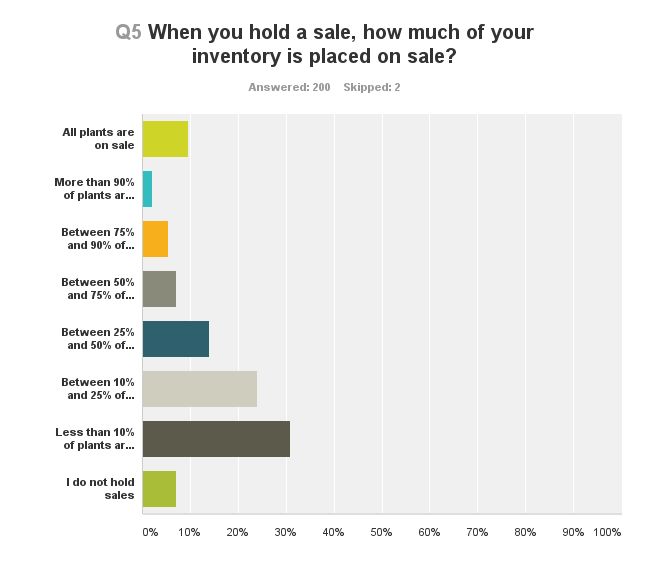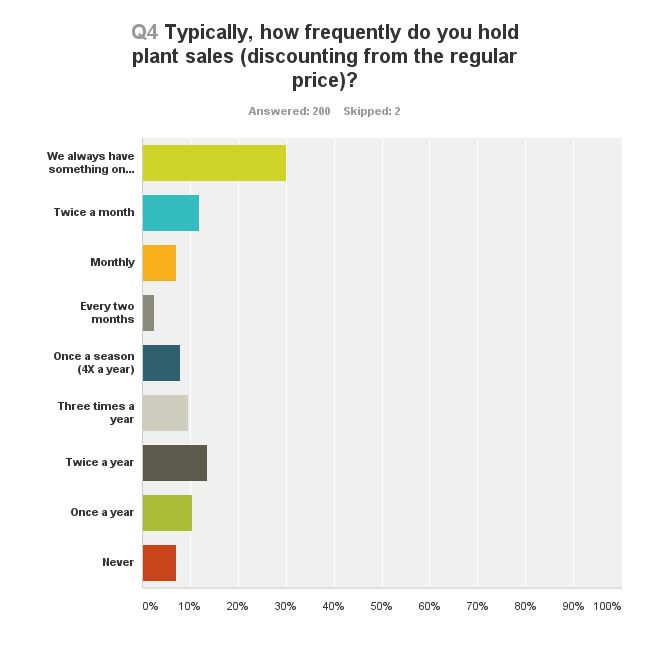How Your Retail Plant Sales Practices Compare
 Editor’s note: Greenhouse Grower RETAILING asked growers and retailers to share their pricing methods in a survey sent out in mid June 2016. Of the 362 responses, 202 arefrom those whose primary business is garden retail. We will be sharing the results of what we learned throughout July, August, and September 2016.
Editor’s note: Greenhouse Grower RETAILING asked growers and retailers to share their pricing methods in a survey sent out in mid June 2016. Of the 362 responses, 202 arefrom those whose primary business is garden retail. We will be sharing the results of what we learned throughout July, August, and September 2016.
Discounting plants is a finely wielded weapon for plant retailers, Greenhouse Grower RETAILING‘s Plant Pricing Survey shows.
It will come as no surprise that just about everyone holds sales at some point (93%). And so it makes sense that some expertise is shown.
Take this first graph as an example. The most perishable plants — small annuals and vegetables — are the most likely to be placed on sale.
That seems counter-intuitive. Why place the fastest turning inventory on sale? But when we took a closer look, we found that these sales are being used to lure more people into the store and are not undercutting overall sales too deeply.
Those who place their small annuals on sale are most likely to do so with only a small percentage of their plants. They are also much less likely to place high margin plants like succulents, trees, tropical plants, etc., on sale.
They are also much more likely to hold those sales at the end of spring than the average garden retailer, which clears out remaining inventory and makes room for those higher margin products.

Timing And Depth Of Sales
At first glance, it’s surprising to see that almost as many retailers hold sales throughout the spring, when you are pretty much guaranteed customers, as those who hold sales at the end of the season:

But when we looked at those who are holding sales throughout the season, we learned that they are much more likely to have fewer than 10% of their plants on sale. A full 55% of those retailers do so, and if you look at the chart below, you’ll see the average is about 30%. And that’s with all the “we hold sales throughout the spring” people factored in.

What that tells us is that about a third of retailers use the strategy of always having something available to satisfy the shoppers who demand a sale, but they protect the prices of the rest of their plants.
This is a practice that Knupper Nursery uses, its owner John Heaton told us a couple years ago. They have at least one variety in each department on sale. That way they are protecting their overall margins while satisfying their bargain shoppers.
Frequency Of Sales
We were curious about the 10% of plant retailers who place all of their plants on sale, so we took a closer look.
These plant retailers practice the opposite strategy of those who always have sales. These retailers are the most likely to hold sales only once or twice a year — 74% of them do so.
Another significant difference is that they place shrubs and trees on sale just as frequently (or more frequently) as vegetables and smaller annuals.
We also took a closer look at the 30% who say they always have something on sale. Not surprisingly, this group tends to be the same group that holds sales throughout the spring season. The majority who use this practice have less the 10% of their plants on sale.

So how do your sales practices compare? Do you agree with the norms in the industry, or should we be changing our strategy?










